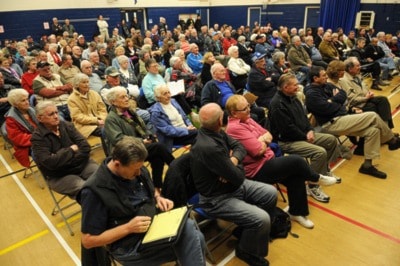The presence of a heavy rail line through the heart of Langley City may not please residents, but even the federal government is powerless to make the railway move.Mike Henderson of Transport Canada made that admission to about 150 residents who attended a public meeting Wednesday night on the “combo” overpass project, which will feature new roads linking 192 Street, 54 Avenue and 196 Street, with three overpasses built over the railway line. He noted that Transport Canada “has no authority to relocate the rail line.” Henderson said that railways are the only modes of transport that own and maintain their own infrastructure, and they own the property the lines are located on.However, the new project displeases many residents, as does the expenditure of $8.5 million in Langley City funds on the project, which has an overall budget of $121 million. Many are residents of Huntsfield Green, a large townhouse complex located just east of the 196 Street road allowance, which will become a two-lane road and critical link in the new route.Robin Johnston, program manager for the Roberts Bank Rail Corridor project, told the crowd that there will eventually be 25 to 35 trains per day using the rail line, some up to 12,000 feet long. The purpose of the combo project and other overpasses along the line is to reduce traffic delays and provide alternative routes to prevent severe traffic congestion due to train movements, he said.In addition to the combo project, a series of “rail advance warning system” signs will be set up in Langley City, Langley Township and Surrey.These will warn drivers that a train is approaching on the rail line, giving them enough time to choose one of the overpasses as an alternative. Several will be set up to the south of the rail line in Langley City on roads such as 208 Street, Fraser Highway, 56 Avenue and 200 Street.Gary Vlieg, Langley City engineer, went over the details of the project with the crowd. The road improvements begin to the south with a four-lane overpass of 192 Street. Some of the 192 Street traffic will continue north on that road, with other traffic travelling east on 54 Avenue in Surrey, crossing the tracks on a second two-lane overpass. Traffic will head east to 196 Street and then north on a two-lane road to 56 Avenue, where there will be a traffic light.From 56 Avenue north, 196 Street becomes four lanes, and will cross both the rail line and Langley Bypass on a long overpass. The road will come back to earth at 196 Street and 60 Avenue, where there will be a new traffic light. From there, 196 Street will continue north as a four-lane road. There will be additional improvements of 196 Street north of Willowbrook Drive, and a traffic light at 196 Street and 64 Avenue.Traffic to and from 60 Avenue will be able to access the Bypass, on a right in, right out basis. The existing right turns from Langley Bypass to 56 Avenue and 56 Avenue to the Bypass will continue, but the winding stretch of 56 Avenue that connects to 192 Street will be closed.As a result of concerns raised at open houses in December, the sound barrier fencing along the 196 Street property line with Huntsfield Green will be extended. The road will be moved as far to the west as possible, and some existing vegetation will be retained.There will be no through truck traffic permitted on 196 Street, and Langley City Mayor Peter Fassbender said that commitment will be put in writing.All City funds going towards the project will come from casino revenue and development cost charge funds, so no property taxes will be used to pay for the project.Vlieg showed a video of traffic on 198 Street at 55 Avenue, which has a traffic volume of 4,000 vehicles per day, to demonstrate likely traffic levels on 196 Street, south of 56 Avenue, where engineers anticipate 3,000 to 5,000 vehicles per day.The video was met with hoots of derision from residents, who felt there was no comparison between the two streets.Work on the project is expected to begin late this year, and will be substantially completed by the end of 2013. Johnston said the work has to be complete by March 31, 2014 in order to qualify for federal funding. The federal government is paying $42.5 million towards the combo project, with another $25.5 million each coming from the province and Port Metro Vancouver. The remainder comes from the two Langleys and Surrey.Rain whistles, coal dust and lack of public input into the Roberts Bank rail overpass program were among the concerns raised by residents Wednesday night.Mike Bethune of Milner said he can sometimes hear every whistle blown from 232 Street to 56 Avenue late at night, and he is convinced that some engineers blow train whistles for longer periods late at night.Johnston said that the overpasses and other improvements to existing crossings will eliminate some of the whistling, in particular at 56 Avenue and possibly at 200 Street.Bethune also said his home is covered with coal dust each year from coal trains, a sentiment echoed by other speakers. He was told that the coal loads are sprayed in an attempt to minimize dust. but the concerns will be taken to the next advisory meeting between City and Canadian Pacific Railway.Another resident asked why decisions about overpasses were made back in 2007, and the public is only getting details now. It was explained that the issue has been under study since 2005, and that a committee of staff from the four municipalities, the federal and provincial governments, port and railways came up with the list of projects in 2007.Roy Mufford said that the issue has been mishandled by the port and senior governments, noting that an environmental assessment of the Roberts Bank port expansion in 2005 specifically excluded Langley, stating that there was no impact on the community from port expansion.
